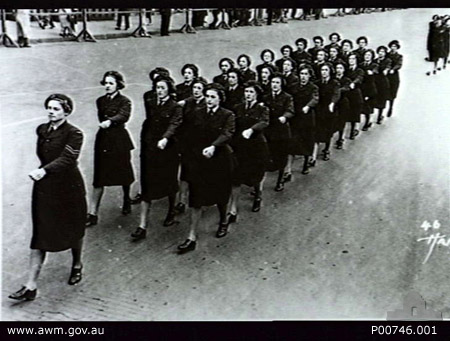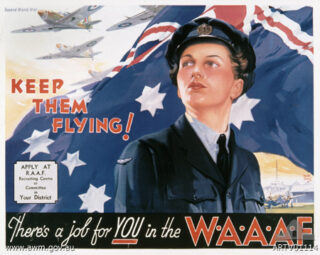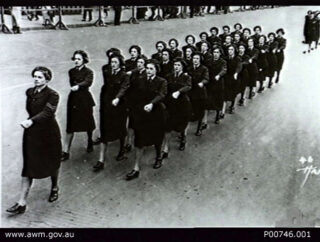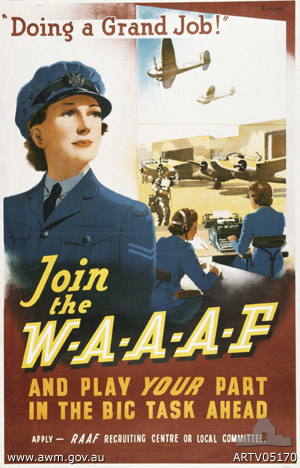- Entry type: Organisation
- Entry ID: AWE0400
Women’s Auxiliary Australian Air Force (WAAAF)
(From 1941 – 1947)
- Occupation Armed services organisation
Summary
The Women’s Auxiliary Australian Air Force (WAAAF) was formed in March 1941 after considerable lobbying by women keen to serve and by the Chief of the Air Staff who wanted to release male personnel serving in Australia for service overseas. The WAAAF was the first and largest of the World War II Australian Women’s Services. It was disbanded in December 1947.
Details
During the early years of World War II the necessity to make use of women in many new avenues of employment became apparent. Despite resistance from some members of the War Cabinet, bureaucrats and the Service, in February 1941 the Royal Australian Air Force (RAAF) received approval to create the Women’s Auxiliary Australian Air Force (WAAAF). Wireless telegraphists were urgently needed to assist in meeting a temporary deficiency of male wireless telegraphists.
A senior WAAAF officer was appointed from 24 February 1941 with more appointed from 10 March 1941 and a WAAAF Training Depot was established at Malvern, Melbourne. Recruiting commenced on 15 March 1941 and on 17 March the first nineteen airwomen reported at the Training Depot, ten of them being teleprinter operator trainees.
Although recruiting continued it was officially slowed down until Japan entered the war in December 1941. Following this event, the three Defence Services recommended the greater employment of women in order to release men for operational duties. By the end of 1941 some 1500 were serving. This number grew to a peak strength of 18,667 officers and airwomen by October 1944. They served in all states of Australia, from Cairns in Northern Queensland to Geraldton in Western Australia.
Airwomen were accepted into 73 different musterings (trades), including highly skilled technical employment on aircraft. In addition to telegraphists, women became armament workers, electricians, fitters, flight mechanics, fabricworkers, instrument makers and meteorological assistants, besides using skills in many clerical, medical, transport, catering, equipment, signals and radar fields of employment. Over 700 women held commissioned rank and like airwomen, worked in a great variety of administrative, technical and professional tasks. A number commanded units in operations rooms, at General Douglas MacArthur’s Headquarters in Brisbane dealing with intelligence matters, at Operational Units, in RAAF Hospitals, Aircraft Depots, Radar Stations, RAAF Bases – wherever they were needed, they served.
Airwomen were paid two-thirds of RAAF male pay for equivalent positions. The officers were paid a good deal less than male officers of equal rank.
Although members were enrolled when the service was first formed, the Women’s Auxiliary Australian Air Force was constituted as a part of the Permanent Air Force by the Air Force (Women’s Services) Regulations (Statutory Rules 1943, No. 69) which came into operation on 24 March 1943. In due course members were given the choice of signing a form of enlistment or attestation in which they volunteered for the duration of the war and twelve months thereafter or returning to civilian life. Very few resigned. Every WAAAF, like the men of the RAAF, was a volunteer.
Listed at the Australian War Memorial in Canberra are the names of 57 WAAAF who died while serving.
Approximately 27000 women saw service in the WAAAF between March 1941 and July 1947 when the last member was discharged from the Force. They proved, together with the women of the Navy and Army and those who worked in munitions factories, the aircraft manufacturing industry, on the land and in all areas where women had been manpowered to replace men, that women could fulfil tasks and roles previously undertaken solely by men.
Group Officer Clare Grant Stevenson was appointed Director of the WAAAF with effect from 9 June 1941 and retired from the Service on 18 March 1946. Her unsparing efforts, in helping to weld the WAAAF into an effective component of the RAAF, were an inspiration to all members. Lady Gowrie, wife of the Governor-General, was the first Honorary Air Commandant of the WAAAF and was followed by Her Royal Highness the Duchess of Gloucester.
The WAAAF was the first Women’s Service to be formed in Australia (excluding the Nursing Services) and members were greatly disappointed that, other than several official visits made by a few to New Guinea, the Solomon Islands and Northern Territory, they were not permitted to serve outside Australia.
The value of the work and the skills of the WAAAF during a period when thousands of men needed to be released for operational duty overseas and Australia itself was at risk, encouraged the formation of the Women’s Royal Australian Air Force (WRAAF) in 1951. This branch of the RAAF was disbanded in 1977 when its members became an integral part of the RAAF.
Archival resources
- Australian War Memorial, Research Centre
-
State Library of New South Wales
- Clare Grant Stevenson - papers, 1941-1947, concerning the Women's Auxiliary Australian Air Force
- Clare Grant Stevenson - further papers, 192--1988, mainly concerning the Women's Auxiliary Australian Air Force, with the papers of Joyce A Thomson concerning Clare Grant Stevenson, 1941- 1992
- Shirley Emilie Shennen - papers, 1923-1991
- Mitchell and Dixson Libraries Manuscripts Collection
- Royal Historical Society of Victoria Inc
Digital resources
Published resources
- Book
-
Resource Section
- WAAAF - an Aussie wartime success story, Doidge, Amber Amber Doidge, 2001, http://www.defence.gov.au/news/raafnews/editions/4404/story10.htm
- The WAAAF, Joyce, J, 2001, http://www.austehc.unimelb.edu.au/fam/0236.html
- WOMEN'S AUXILIARY AUSTRALIAN AIR FORCE (WAAAF) IN AUSTRALIA DURING WW2, Dunn, Peter, 2002, http://home.st.net.au/~dunn/waaaf/waaaf.htm
- RAAF Museum Point Cook Home Page, RAAF Museum Point Cook, 2002, http://www.raafmuseum.com.au/
- Women in Air Force, RAAF, 1995, http://www.defence.gov.au/raaf/history/women.htm
- Journal Article
- Newspaper Article
- Resource
Related entries
-
Related Women
-
Davis, Mervyn Twynam (1916 - 1985)
-
Blackwood, Margaret (1909 - 1986)
-
Beaurepaire, Beryl Edith (1923 - 2018)
-
McKenzie, Florence Violet (1892 - 1982)
-
Stone, June (1922 - 2005)
-
Palmer, Helen Gwynneth (1917 - 1979)
-
Evans, Beryl Alice (1922 - 2006)
-
Darling, Honor Brinsley (1918 - 2000)
-
Dynon, Moira Lenore (1920 - 1976)
-
Ball, Betty Elva (1922 - 2016)
-
Linnane, Joyce Enid (Joy) (1919 - 2012)
-
Cameron, Elizabeth Katherine (Betty) (1918 - 2011)
-
Utting, Margaret (Peg) Vivian Moile (1922 - 2023)
-
Craig, Audrey Beatrice (1910 - 1994)
-
Eales, Jean (1915 - 1989)
-
Carter, Doris Jessie (1912 - 1999)
-
Frost, Catherine Adelaide Marcelle (1921 - 2013)
-
Price, Eileen May (1921 - 1996)
-
Backhouse, Enid (Elizabeth) (1917 - 2013)
-
Campbell, Margery (1919 - 2013)
-
Hawthorn, Dorothy (1901 - 1983)
-
Friend, Gwen (1923 - 2016)
-
Miller, Mabel Flora (1906 - 1978)
-
Stark, Amy Gwendoline (1910 - 1994)
-
Davis, Mervyn Twynam (1916 - 1985)
-
Director/s
-
Subsequent
-
Related Organisations
-
Member


